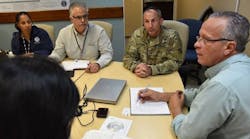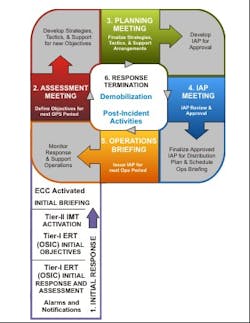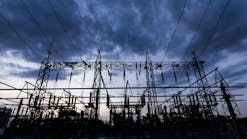Hurricane Maria bulldozed Puerto Rico on September 20, 2017, just two weeks after Hurricane Irma hit the island. There have been hundreds, maybe thousands, of news stories about the politics and logistics surrounding the restoration after Maria, a Category 4 hurricane with winds just a few miles per hour below Category 5. What hasn’t been reported is how the organizations tasked with restoring power organized behind the scenes to take command of the situation.
To get that story, I interviewed people who led the response. I spoke with individuals such as Carlos Torres, the Power Restoration Coordinator in Puerto Rico and a member of the Unified Command Group; Colonel John Lloyd, who was commander for Task Force Power with the U.S. Army Corps of Engineers (USACE); and Mike Menges, senior manager for Preparedness & Distribution Operations for Edison Electric Institute.
The call for mutual assistance from officials in Puerto Rico went out on October 31, 2017. Torres arrived on the island on November 3 with Manny Miranda, a senior vice president at Florida Power & Light. A few weeks later, Puerto Rico Governor Ricardo Rosselló appointed Torres as Power Restoration Coordinator, about six weeks after the hurricane. A month earlier, Torres had wrapped up a 32-year career with Con Edison culminating in his role as vice president of Emergency Preparedness & Business Resiliency; during his time at Con Edison, he managed restoration and emergencies ranging from Superstorm Sandy to the 9/11 attacks. After reflecting on the damage in Puerto Rico, Torres says, “We have never been tested more than in the response and recovery effort in Puerto Rico following Hurricane Maria.”
Eighty percent of the island’s 2,400 miles of transmission lines, 30,000 miles of distribution lines and 300 substations were destroyed. Along with the ripped-up infrastructure were severely damaged roads, many wiped away, which made it incredibly difficult to navigate and orient for damage assessment as well as restoration and recovery activities. In a situation like this, experts say, the Puerto Rico Electric Power Authority (PREPA), the state-owned utility, should have operated and led through the Incident Command System (ICS). But the extent of the devastation limited the utility’s ability to perform this function.
So, the restoration’s leading players tore pages from the playbook of the National Incident Management System (NIMS). According to the NIMS, which FEMA publishes, “When no one jurisdiction, agency or organization has primary authority and/or the resources to manage an incident on its own, Unified Command may be established. In Unified Command, there is no one ‘commander.’”
Four heads make one
After Maria, FEMA tapped the USACE as the lead agency for grid restoration on the island. Colonel Lloyd arrived in Puerto Rico from the U.S. Virgin Islands where he had helped with a recovery mission after Hurricane Irma. Years before, Lloyd served as the Army’s task force commander for Superstorm Sandy. The USACE then worked with EEI, FEMA, PREPA and others to launch a unified command comprised of Torres; Lloyd; Dr. Ahsha Tribble, the Power Sector Chief for Response and the Infrastructure Chief for Recovery at FEMA, and Justo González, interim executive director of PREPA.
“PREPA was making the decisions about system priorities and what material to order,” says Lloyd. “But we worked closely with them every day to help make decisions that provided the safest, quickest way to restore power.”
“I don’t think we ever discussed having one person with overall control,” says Menges. “Even when the governor named Carlos as Power Restoration Coordinator, everyone agreed we needed that unified command.”
“I was a partner,” adds Torres, who is also a consultant for EEI, “but I decided I was the tiebreaker in the event we needed one.”
Torres notes that the unified command wasn’t a textbook ICS implementation in the utility industry. But he feels the utility industry doesn’t necessarily need to operate in a textbook manner since during a mutual assistance response the supporting utility companies work under the host utility in control of the restoration effort. According to Torres, utility professionals deploy and operate within ICS to manage priorities and operate communication at all levels. The Planning “P” (see Figure 1 below), a guide for developing incident action plans, is the cornerstone of ICS and, says Torres, the key for “driving through the objectives and mission.”
“In Puerto Rico, there were incident management teams under me,” Torres says. “The Army had its supply chain, communications team and engineering group. FEMA had theirs. PREPA had a similar structure. PREPA’s teams weren’t exactly operating under ICS, so the IMTs added elements to supplement them.”
A key piece was communications and the public information officer (PIO) role was important. The PIO developed a communication strategy, both for internal and external stakeholders. A unified communication group put together a communication strategy, including social media, focused on what Torres called, “Unity of effort and message.”
The unified command and central IMT was based at PREPA’s San Juan headquarters, with a regional IMT in each of the seven regional offices of San Juan, Mayagüez, Ponce, Arecibo, Bayamón, Carolina and Caguas. Each region included a regional incident commander working with PREPA as well as the USACE regional leaders. Torres says the unified command involved a daily cadence of meetings including situational awareness calls each morning where the regions reported the prior day’s progress and issues to address. There were also daily calls to discuss any incidents, follow-ups and safety messaging to all personnel. Every meeting started with safety – Torres says that was the single most important element of the restoration effort. Each week there were separate operations and planning meetings focused on transmission and distribution restoration. The IMTs included a team that evaluated incidents and communicated to the field; they also created switching guidelines. Since there were limited resources on the island, the electric industry crews handled their own switching. There weren’t enough PREPA switching crews on hand, and they were focused on switching for the PREPA and USACE contractors as well as the PREPA crews.
“If we had had to wait for PREPA for all switching,” adds Torres, “then it would’ve taken forever, so I grabbed industry folks from each IMT and codified the switching guidelines, while the USACE and FEMA listened to the protocols.” That said, Torres also told the island’s governor that “If it’s not safe, we’re not turning the power on.”
To inform stakeholders, Torres opened the unified command meetings to a larger group. Eventually, meetings became unwieldy, with upwards of 40 people in the room. The command picked certain days of the week for the stakeholders to attend and receive reports, while Torres reserved other days for the four unified command members to meet, along with the PREPA board chairman. The unified command didn’t create an incident action plan for each day. Instead, the group developed several plans for repair of the distribution system, substations and the transmission system; these plans spelled out the work. PREPA prioritized it. And the IMTs and PREPA regional teams updated the plans with completed work.
“The key was the planning between FEMA, PREPA, the USACE and industry,” says Torres. “Ninety percent of the transmission lines and 85 percent of the distribution system was down. Without coordination, we would’ve burned up wires and tripped units because we wouldn’t have matched loads.”
At the peak of the effort in February 2018, there were men and women from 40 U.S. utilities on the island restoring power. By the end of May 2018, 99.1 percent of the customers on the island had their power restored – that same month Torres wrapped up his duties. And by mid-August 2018, all of the storm-related customers were back in service.
Looking back, looking forward
Torres says no one company could have restored power in the aftermath of a situation like the one in Puerto Rico. The damage assessment process was hamstrung, in large part, by impassable roads and assessments carried out in different ways, by different organizations. Torres says the unified command was critical to developing one picture of the damage and a plan to fix the system. Some interviewees thought in a future situation like Maria that mobile damage assessment technology could standardize data collection, enabling real-time reporting and requisition of materials.
The unified command quickly learned that equipment and materials in Puerto Rico had not been stockpiled in the quantities these items are typically found on-site at mainland utilities. Waiting for damage assessments and then requesting crews and equipment and transporting both from the mainland to the island prolonged the outages.
Puerto Rico had made very little investment in grid hardening and smart meters – strategies that had helped speed up restoration after Hurricane Harvey. PREPA’s lack of vegetation management made working around and repairing infrastructure slow and difficult. One critical best practice coming from the effort was the use of regional IMTs. According to Brian Reil, senior manager of media relations for EEI, the IMTs reported up to the operations, planning and logistics leads. The IMTs forged a partnership between PREPA and the utility industry. Every IMT had a leader in each region along with a PREPA and USACE counterpart.
“The PREPA person’s local expertise of the territory and where the critical customers were located was invaluable for getting to feeders and handling lockout,” recalls Menges. “The IMT industry leader brought top-flight restoration experience from the mainland.”
In Lloyd’s opinion, the unified command approach effectively addressed multiple issues daily, and, most importantly, created a synergy across many organizations and agencies. He believes that single-mindedness fast-tracked decisions in the best interest of restoring power for the people of Puerto Rico.



